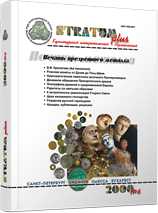Иконография образа «Святой Георгий на троне» в средние века
Medieval Icons of St. George on Throne
Author(s): Georgi AtanasovSubject(s): History, History of ideas, Middle Ages, Modern Age, 6th to 12th Centuries, 13th to 14th Centuries, 15th Century, 16th Century, 17th Century, History of Religion
Published by: Издательский дом Stratum, Университет «Высшая антропологическая школа»
Summary/Abstract: The article studies rather rare but interesting icons of St. George on Throne which appeared in XII-XIII and widely spread by XV-XVII. An icon made of bone recently found in Chersoneses, however, suggests a need to review the theory. From the stylistic and iconographical viewpoint, the artifact found in Crimea is connected with the late Macedonian neoclassicism of the second half of X - early XI c., which supports an earlier origin of the image. It seems to be connected with contamination of iconographies of emperors and saints, which, according to A. Grabar’, can be observed most often. The Medieval written records on St. George do not contain direct references to appearance of the icons with the saint on throne. It is an explanation to their later appearance and limited spread. If this icon was to be met rarely in XII-XIII cc., when along with St. George, St. Dimitri and St. Theodor were depicted in the same way, then already from the late XIV - early XV c. it becomes typical only to St. George. This is the period by which the icon from Sofia was dated, and it is the most delicate image of St. George on throne. So far, this icon has been dated by XVI c., but its style and iconographical analysis reveal late Paleolog stylistic features of the late XIV - early XV c. St. George on Throne icons got widest spread in the late XV - XVII cc. Particularly, on banners, St. George is depicted wearing Moldavian princes’ crown in the form of a lily. Taking into account a downcast dragon lying at his feet, one can see here a contamination of the images of a saint-triumphant and an emperor-triumphant – a tradition with roots already in Byzantine art of X c., spread thereafter from the post-Byzantine territory in XV c.
Journal: Stratum plus. Археология и культурная антропология
- Issue Year: 2000
- Issue No: 6
- Page Range: 290-296
- Page Count: 7
- Language: Russian
- Content File-PDF

